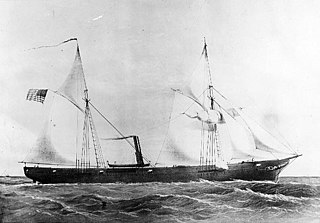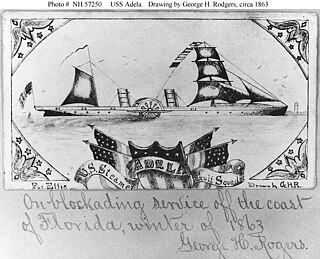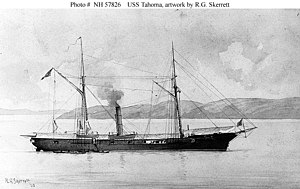USS New London was a screw steamer of the Union Navy during the American Civil War. She was outfitted with a Parrott rifle and 32-pounders, and was assigned as a gunboat in the Union blockade of the Confederate States of America.

USS Sciota was a Unadilla-class gunboat built on behalf of the United States Navy for service during the Civil War. She was outfitted as a gunboat, with both a 20-pounder rifle for horizontal firing, and two howitzers for shore bombardment, and assigned to the Union blockade of the waterways of the Confederate States of America.

USS Stars and Stripes was a 407-ton steamer acquired by the U.S. Navy and put to use by the Union during the American Civil War.

USS Kennebec was a Unadilla-class gunboat built for the U.S. Navy following the outbreak of the American Civil War. She was named for the Kennebec River.

USS Sagamore was a Unadilla-class gunboat built on behalf of the United States Navy for service during the American Civil War. She was outfitted as a gunboat and assigned to the Union blockade of the Confederate States of America. Sagamore was very active during the war, and served the Union both as a patrol ship and a bombardment vessel.
USS Penobscot was a Unadilla-class gunboat built for the Union Navy during the American Civil War.

USS Morning Light was a sailing ship acquired by the Union Navy during the American Civil War. She was used by the Navy to patrol navigable waterways of the Confederacy to prevent the South from trading with other countries.
USS Sea Bird was a captured Confederate schooner acquired by the Union Navy from the prize court during the American Civil War.
USS Fox was a captured Confederate schooner acquired by the Union Navy from the prize court during the American Civil War.
USS Two Sisters was a small 54-ton captured Confederate schooner acquired by the Union Navy from the prize court during the American Civil War.
USS Nita was a captured Confederate steamer acquired by the Union Navy from the prize court during the American Civil War. She was put into service by the Union Navy to patrol navigable waterways of the Confederacy to prevent the South from trading with other countries.
USS Sunflower was a 294-ton steamer acquired by the Union Navy during the American Civil War.
USS Restless was a barque acquired by the Union Navy during the American Civil War.
USS Roebuck was a barque used by the Union Navy during the American Civil War.

USS Kanawha was a Unadilla-class gunboat built for the Union Navy during the American Civil War. She was used by the navy to patrol navigable waterways of the Confederacy to prevent the South from trading with other countries.
USS Brockenborough was a sloop captured by the Union Navy during the American Civil War.
USS Matthew Vassar was a schooner purchased by the Union Navy during the American Civil War. She was used by the Union Navy primarily as a mortar gunboat, but also as a gunboat stationed off Confederate ports to prevent their trading with foreign countries.

USS Adela was a steamer captured by the Union Navy during the American Civil War. She was used by the Union Navy as a gunboat in support of the Union Navy blockade of Confederate waterways.
The third USS Virginia was a 581-ton blockade-running steamer captured by the United States Navy and put to use by the Union Navy during the American Civil War. Virginia served the U.S. Navy primarily as a mortar gunboat. Her ordnance included six 24-pounder howitzers and a 12-pounder rifled gun.

John Cummings Howell was an officer in the United States Navy during the American Civil War. He rose to the rank of rear admiral and late in his career was commander-in-chief of the North Atlantic Squadron and then of the European Squadron.








